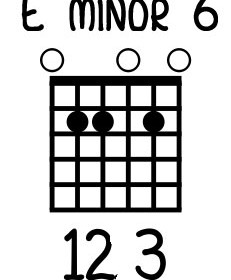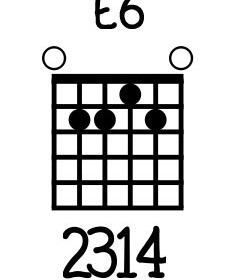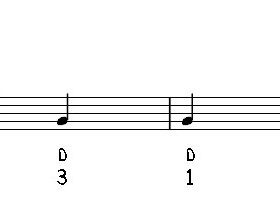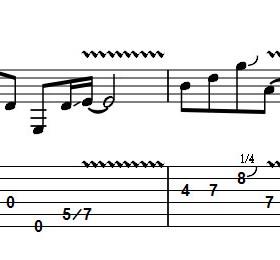-

Cool 9th Chords
9th chords are 7th chords with an extra note added on top. These chords can help to create a sophisticated and cool sound to your guitar playing and are great chords for blues, funk and jazz.
Dominant 9th Chord
The most common 9th chord is the dominant 9th chord normally just called a 9th chord. The 9th chord and is based on the dominant 7th chord with the 9th scale note added. For example the C9 chord consists of the notes C E G Bb and D. The D note is the 9th note away from the root C note in the chord.If the chord doesn’t contain the flattened 7th (Bb) note it isn’t a 9th chord but an “add 9” chord (e.g. C E G D) which sounds quite different. Read More
-

Open String Minor Chord Variations
Last time we looked at variations you can use for open string major chords. Of course for every major chord there is a minor chord too. So of course there are variations for the open string minor chords too.
D Minor
For the open string D minor chord there are 2 common suspended chords.Which are actually the same as the Dsus2 and Dsus4 chords used with the D major chord. However in this case the fingers used will be different. To go to Dsus2 from D minor finger 1 is removed with fingers 2 and 3 staying in place. For Dsus4 fingers 2 and 3 remain in place again and finger 4 is added to fret 3 on the 1st string.
D minor 7 is another handy chord variation to know. Read More -

Open String Major Chord Variations
One of the most common questions my students ask is how to make a 3 or 4 chord song interesting.
The trick is to play variations of the chords using different notes than just the ones the standard major or minor chord shapes use. Here we will look at some common open string chord variations that can be used to make any song sound more interesting.D Major
First off we’ll look at one of the 2 most common chord variations on guitar based around the D major chord.
Dsus2 or D suspended 2nd is a chord that replaces the 3rd (or in this case the major 3rd F#) with the 2nd note of the scale which for a D chord is the E note. So here you play the open 1st E string which means that you only need 2 fingers to play this chord. Read More
-

12 Beginner Guitar Strumming Patterns
As a beginner guitarist the two essentials you need to learn to play songs are chords and strumming patterns. So after learning the basic open string chords what are the strumming patterns that every beginner guitarist needs to know? The following 12 strumming patterns and rhythms enable you to strum your guitar through many songs from The Beatles, The Eagles, The Rolling Stones, Bob Dylan and many more.
4/4 Strumming Patterns
Most pop/rock songs are in 4/4 time meaning that there are 4 quarter notes beat to the bar. With most strumming patterns you strum DOWN on each beat. The 4 beats can also be divided in half creating eight beats in the bar funnily enough they’re called eighth beats. Read More -

7 Essential Jimi Hendrix Guitar Techniques
Jimi Hendrix is one of the most influential guitarists in the history of rock music. He revolutionised rock n roll guitar incorporating the use of effects such as fuzz, wah-wah, octavia, feedback and more. He also had great rhythm and lead guitar technique which can be heard in his music ranging from quiet ballads to aggressive rock. His style of playing paved the way for hard rock, heavy rock and metal. However his playing wasn’t just about turning it up to 11!
Here we will look at 7 essential techniques for every guitarist to learn and how they were used in some of his most famous songs.
Purple Haze1. Read More



